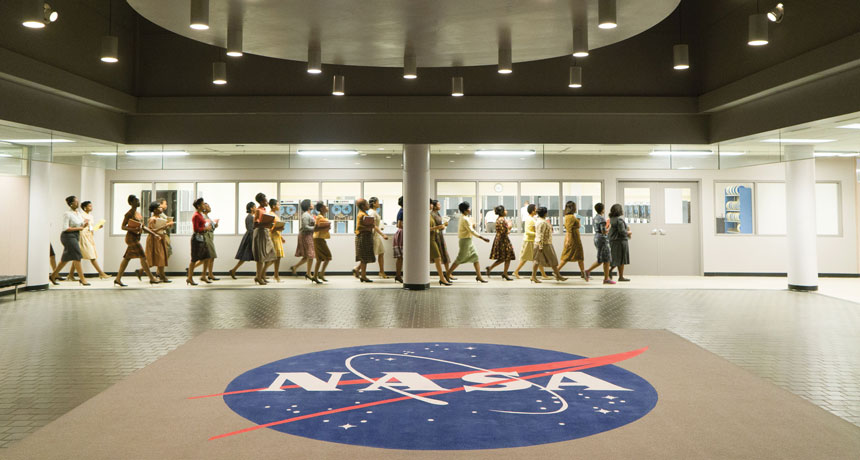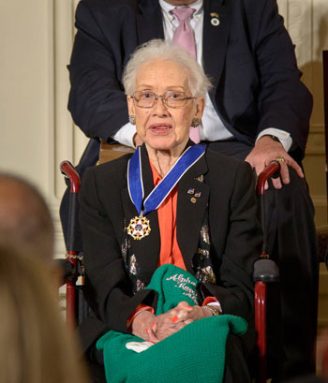Movie, book illuminate Hidden Figures from the space race
How women of color helped shoot a man into space

Before the age of computers, people — including women of color — helped run the numbers that put humans into space.
HOPPER STONE, TM & © 2016 TWENTIETH CENTURY FOX FILM CORPORATION
Share this:
- Share via email (Opens in new window) Email
- Click to share on Facebook (Opens in new window) Facebook
- Click to share on X (Opens in new window) X
- Click to share on Pinterest (Opens in new window) Pinterest
- Click to share on Reddit (Opens in new window) Reddit
- Share to Google Classroom (Opens in new window) Google Classroom
- Click to print (Opens in new window) Print
There was a time — not so long ago — when computers were people. They were mathematicians. Like modern computers, they put together numbers in complex equations. They just used pencils and paper and brains instead of electronic circuits. Their equations helped fly planes, rockets and space shuttles. Now, a new book and movie tell the stories of a few of the computers. They were women of color who proved their math skills in the face of segregation and sexism. And their work helped the United States win the space race.
Hidden Figures comes to U.S. theaters nationwide on January 6
The film Hidden Figures follows three of these computers — Dorothy Vaughn, Katherine Johnson and Mary Jackson. (Octavia Spencer, Taraji P. Henson and Janelle Monáe play these roles, respectively, in the movie.) All three worked at the National Aeronautics and Space Administration (NASA) Langley Research Center in Hampton Roads, Va. Their skills in math and engineering helped to put astronaut John Glenn into orbit around the Earth in 1962.
The movie is based on the book Hidden Figures: The American Dream and the Untold Story of the Black Women Mathematicians Who Helped Win the Space Race. In it, author Margot Lee Shetterly follows Vaughn, Johnson, Jackson and other black women in their careers at Langley.
These women were hired as computers during and following World War II. They ran the numbers for engineers constructing new and improved airplanes at the National Advisory Committee for Aeronautics (NACA). In 1958, they moved from planes to spacecraft as NACA became NASA.
Until recently, few people knew that there were black women working as computers. Even Shetterly was surprised to learn of their existence. And once she learned about Johnson, Vaughn and Jackson, she got another surprise.
There were more.
She discovered that the office they worked in, called West Computing, “was a group of 25 women, black women….They were working around the clock during World War II, and they were at the leading edge of aeronautical research,” Shetterly said during a reading and panel for students on December 14 at the Martin Luther King, Jr. Memorial Library in Washington, D.C. “You hear women aren’t good at math, or women aren’t good at science, all of these things. Here is the mathematical documentary evidence proving that wrong,” she said.
At first, math might not seem like the most heroic subject for a movie. But the film (which includes a stellar soundtrack by Pharrell Williams) shows female mathematicians can evoke just as much drama as men in space suits. Johnson, Jackson and Vaughn stand out, the focus in every scene. They maintain their confidence in their professional skills in the face of racism and sexism. They move through the world of Langley with spirit, mathematical genius and clever one-liners.

Even though many people around the world know that Glenn orbited the Earth and returned safely, the film provides plenty of tension as Johnson’s math is put to the test. Again and again, she saves the day with her mathematical skills. And when she put up a huge, complex equation on a chalkboard to send a person to space, the audience in the movie theater burst into applause.
The movie isn’t a faithful retelling of the book. Instead, it takes on only the chapters surrounding Glenn’s famous flight. In the process, it does jumble some of the timeline. New people and some new events get invented. Johnson had two and a half days to re-run the calculations for Glenn’s flight, not the few hours depicted in the movie. While Jackson’s entry into engineering classes is highlighted, her later frustration in her career was not.
The book, in both the young readers’ edition and the original, gives a more complex picture and covers more time.
The library event included a panel of modern NASA engineers and scientists of color, people who have followed in the computers’ footsteps. Shani Roy, 17, is a senior at McKinley Technology High School in Washington, D.C. She said she was inspired after hearing from the scientists and listening to Shetterly read a passage from the book. Roy explained why: “This one woman [Johnson], she was the one factor that was going to lead this man into space, because he depended on her reasoning.” Roy was impressed, she said, “that one person could be that important.” Hearing the stories of these women inspired her to work to overcome her own obstacles as she pursues her own career in science, she said.
Langley started hiring people of color in various roles during World War II. Many computers stayed on after the war, studying airplanes under NACA and then rockets and space shuttles with NASA. NASA eventually traded pencils and calculators for the first computing machines (what we now call computers). And the human computers went on to become supervisors, computer programmers and engineers. Along the way, these women went through the Civil Rights Movement and saw better opportunities for women and people of color. And they eventually gained recognition for their efforts. For one, that recognition came from President Barack Obama. In 2015, he gave Johnson the Presidential Medal of Freedom for her work helping to put people in space.
Buy Hidden Figures: The American Dream and the Untold Story of the Black Women Mathematicians Who Helped Win the Space Race: Sales generated through the links to Amazon.com contribute to Society for Science & the Public’s programs.
Buy Hidden Figures Young Readers’ Edition: Sales generated through the links to Amazon.com contribute to Society for Science & the Public’s programs.
Follow Eureka! Lab on Twitter






